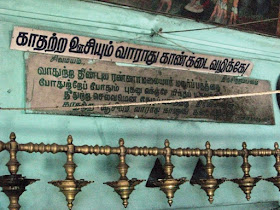Pattinathar Temple, Thiruvotriyur – The Temple
The Temple is situated on the
shores of Bay of Bengal. There is no tower or vimanas. The entrance of the
temple is not tall. The devotee has to enter bending the neck as a mark of
humility. The saint Pattinathar is
facing the sea from a separate shrine in a Linga form on a square peeta (stage).
The traditional Nagabarana (the divine snake jewel on the head of Linga) is
also placed on the idol.
The saint is considered as
Lord Shiva and pujas performed accordingly. There are 27 lamps in his shrine
representing 27 stars. Ghee is used to light the lamps. The sacred ash used for
the abishek is offered as Prasad. This is actually a Jeeva Samadhi Temple. The
Sanctum housing the Linga is the burial spot of the mortal remains of
Pattinathar, the 15th century saint. While a superstructure
appears to have existed even in early times, the present structure over the
sepulcher cannot be more than some 100 years old.
The superstructure over the
Samadhi is a building of low height which has a flat ceiling comprising wooden
planks above which is a vaulted roof. It is divided into three sections – a
congregational hall in the front, a narrow vestibule in the middle and the
sanctum at the rear. Flooring is of black slabs probably of the Cuddappah
variety and the walls are of chunam. The building is fronted by a space covered
by a sloping roof structure with Mangalore tiles.
Nandhi can be found facing the
sanctum. Lord Vinayaka and Lord Muruga can be found in the front mandapam.
Chandikeswara graces from his usual location in the prakaram. Sthala Vriksham
is Vilwa and Theertham is Bay of Bengal.










